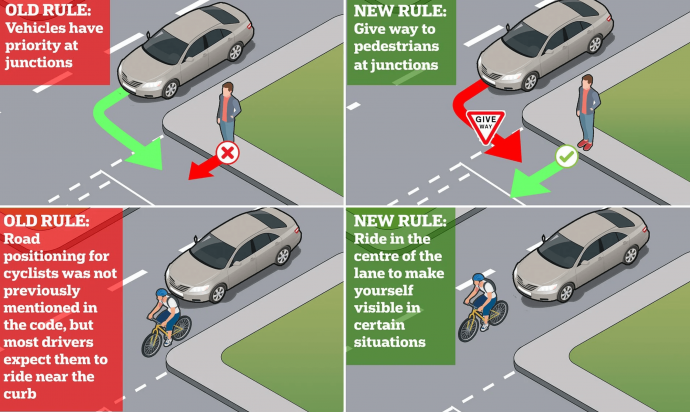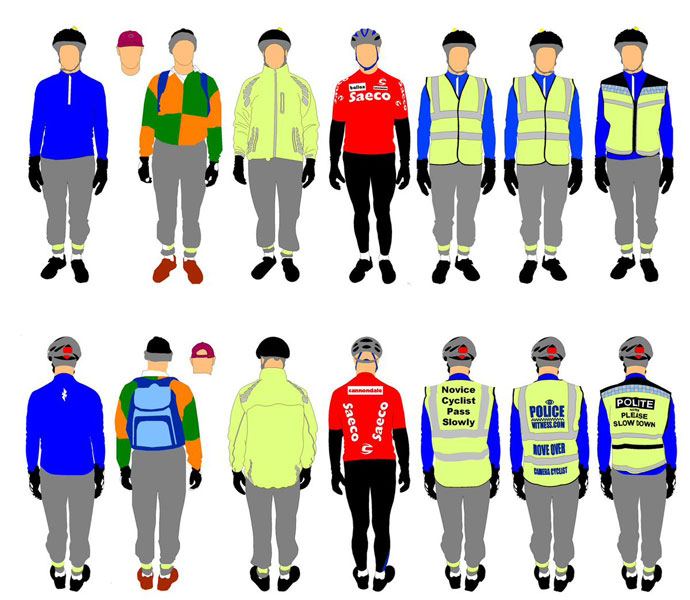
Why are certain media outlets so upset by this month’s changes to the Highway Code? After all many of the changes aren’t even new. For example, cycling centrally in a lane isn’t a new rule, it’s been in the Highway Code for years.
The revised Highway Code introduces a hierarchy of responsibility to British roads. The change requires those who could cause the greatest harm to bear the greatest responsibility of reducing danger on the road. This long-overdue does of commonsense means there will exist a legal hierarchy of road users.
Pedestrians are at the top of the pyramid because they pose the least risk to others whereas heavy goods vehicles have the potential to do the greatest harm. The concept of there being a hierarchy of road users is one of a number of changes intended to make our roads safer for vulnerable road users.
For example, new rules will also mean pedestrians will take priority when waiting to cross a road vehicles are turning into and cyclists will be given priority over vehicles in some aspects.

However, the changes have given those who wish to maintain the status quo an excuse to stoke antagonism between road users. According to West Midlands Cycling & Walking Commissioner Adam Tranter, “Some media outlets could have used their platform to educate, inform and even scrutinise changes to the Highway Code. But instead used it as an opportunity to stir division and chase engagement via lazy tropes and wilful misrepresentation.”
Nobody knows for certain why some drivers insist on overtaking cyclists too close. Impatience? A sense of entitlement? A lack of spatial awareness? No one can say for certain, but it’s not because they’ve failed to spot the person on the bicycle.
If this sounds counter-intuitive, take note of Dr Ian Walker, Senior Lecturer in Psychology at Bath University – his research focuses particularly on the safety of vulnerable road users and their interactions with motorists, considering such issues as road user attitudes and stereotypes, and the roles of urban design and policy in affecting vulnerable road users’ safety. Dr Walker has conducted research to monitor cars when they overtake cyclists wearing a variety of high-visibility and disruptive pattern clothing.

Dr Walker found that outfits in the study (except the one with the word ‘police’) were treated exactly the same, almost to the centimetre.
It seems likely that, ‘punishment passes’ aside, close overtaking is a product of ineptitude on the part of drivers. It doesn’t help that so few people in Britain now cycle. When we travelled to the Netherlands last year to shoot our documentary about road danger, Stop Killing our Children, we spoke to Vim Bot – national and international policy adviser for the Fietsersbond, the Dutch Cyclists’ Union:
“Foreign observers notice that behaviour of car drivers in the Netherlands is better than in their own country, and certainly than that in Britain – I think it has to do with the fact that cycling is part of everyday culture in the Netherlands. It means that most car drivers will cycle themselves, or they will have cycle as a child, or they will have their children cycling so they know that there are cyclists everywhere.”
Do cars rob drivers of their humanity?
Australian research on attitudes towards cyclists last year found that 49 per cent of non-cyclists viewed people who ride a bike as non-human, according to the study which was published in the journal Transportation Research.
The research concludes that studies have shown that dehumanisation is associated with increased antisocial behaviour and aggression toward a variety of groups, and that it does so by removing normal inhibitions against harming others. Attitudes were measured by asking people to respond with how much they agreed with statements such as “I feel like cyclists are mechanical and cold, like a robot.”
The study also sought to connect dehumanisation to aggressive behaviour toward cyclists — which was measured by asking respondents if they had ever driven close to a cyclist on purpose, or behaved aggressively in another way.
The study found that the more dehumanisation a person admitted to, the more likely that they behaved aggressively towards a person on a bike. Driving, it seems, robs many of their humanity.
The research team did not make specific recommendations about how to improve attitudes toward cyclists, but speculated that Australia’s mandatory helmet law may exacerbate the problem by obscuring riders heads and faces. It’s a hypothesis that’s supported by Dr Ian Walker, who used a bicycle fitted with a computer and an ultrasonic distance sensor to record data from over 2,500 overtaking motorists in Salisbury and Bristol.
Dr Walker, who was struck by a bus and a lorry in the course of the experiment, spent half the time wearing a cycle helmet and half the time bare-headed. He was wearing the helmet both times he was struck.
He found that drivers were as much as twice as likely to get particularly close to the bicycle when he was wearing the helmet. To test another theory, Dr Walker donned a long wig to see whether there was any difference in passing distance when drivers thought they were overtaking what appeared to be a female cyclist.
Whilst wearing the wig, drivers gave him an average of 14 centimetres more space when passing.
Across the board, drivers passed an average of 8.5 cm closer with the helmet than without. According to Dr Walker: “This study shows that when drivers overtake a cyclist, the margin for error they leave is affected by the cyclist’s appearance”.
The ethical choice
The ETA was established in 1990 as an ethical provider of green, reliable travel services. Over 30 years on, we continue to offer cycle insurance (covers cargo bikes), breakdown cover and mobility scooter insurance while putting concern for the environment at the heart of all we do.
The Good Shopping Guide judges us to be the UK’s most ethical provider.
Nick Marshall
Why do you not say which media outlets these are? As a result, they continue to feel impunity and will continue their campaigns against anything progressive. Please list them and let us know which these vile but highly influential media outlets we’re dealing with.
Patricia Richardson
Nothing has change where I live, still ignore pedestrians, take them all the time to stop for red lights.
Seems we have been well taken over by vehicles.
Most times like a race track.
Can’t argue with them as you are putting yourself in harm’s way.
The major thing I don’t like, is fitting children & babies into cars, on the off side. Just get out of cars, and open doors. Also pulling up on wrong side of road, with headlights beaming into oncoming traffic
Yes I am a driver, but we were taught proper to be courtious